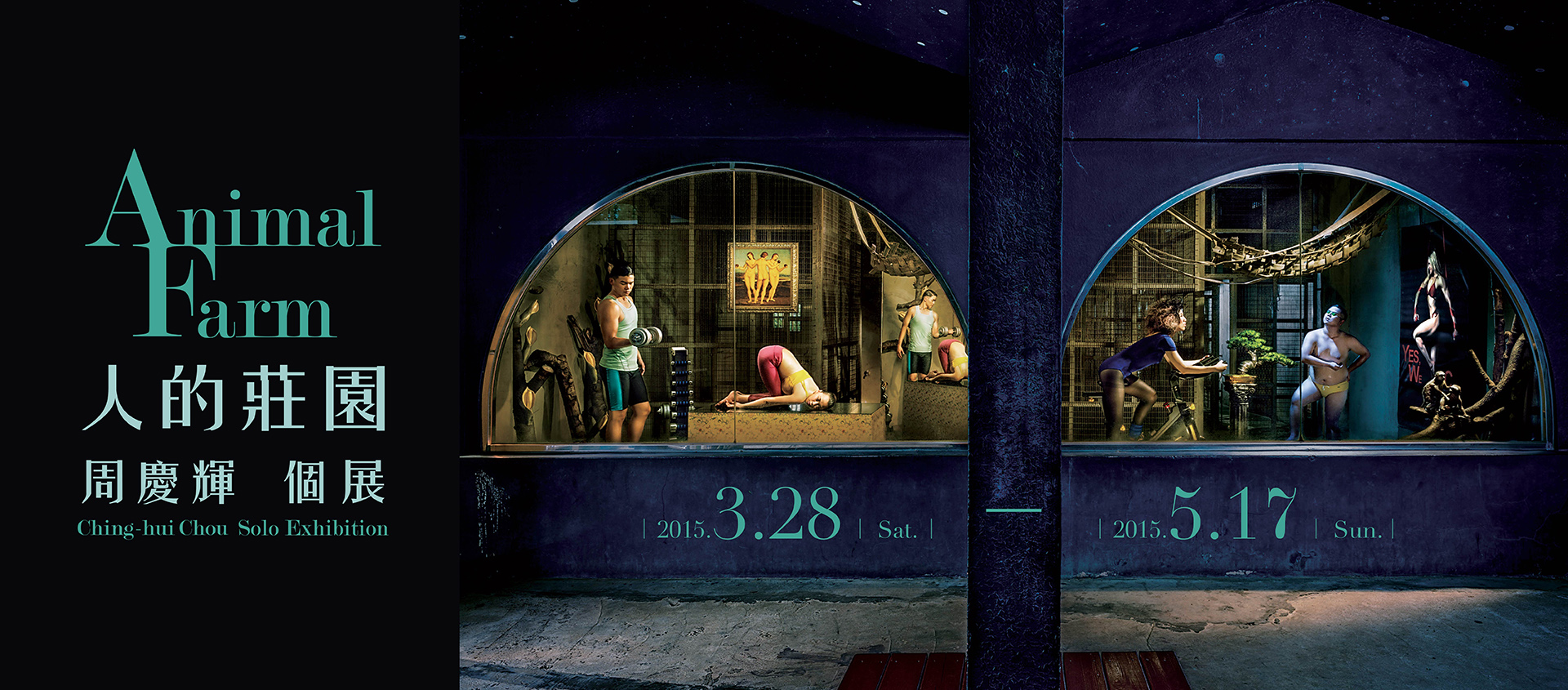

台北當代藝術館 官方網站 Museum of Contemporary Art, Taipei
Friday 星期五
10AM - 6PM



Friday 星期五
10AM - 6PM
EXHIBITIONS & EVENTS 展覽活動

2015 / 03 / 28 Sat.
2015 / 05 / 17 Sun.
10:00 - 18:00
從1990年開始,周慶輝透過攝影,深入寫照當代社會中的特定生活群體,他非常重視與對象團體之間的互動信賴,在按下快門之前,也要求自己對某些現象事實先做過調查研究和理解;歷年來,他的攝影作品雖從社會現實出發,並立意結合藝術表現手法和社會劇場概念,他相信「創作攝影」的言說方式,更足以呈現和詮釋人們熟知的一些生活故事。以「停格的歲月—痲瘋村紀事」為例,他說:「很多攝影人是拍完照片才開始組合構思,而我是先有攝影計畫才進行攝影工作。真正的恐怖不是痲瘋病本身,而是人們對疾病的想像,我想拍出人們對疾病的想像。第一個角度是他們如何面對死亡,因為他們得病之後的所有生活都在這裡,包括死後火葬、骨灰塔等。第二個角度是宗教,他們因病被隔絶在這裡,宗教寄託對他們而言非常重要,第三個角度是日常生活與醫療。」 周慶輝此次個展【人的莊園】,源自一個長達五年、投入眾多人力與資源的拍攝計畫;他以動物園為創作發想和拍攝場域,雙向鋪陳了現代文明生活的浮華與困境;整個創作過程,包括構想文案、申請場地、籌募資金、徵求演員、張羅設備、製作道具…等各階段工作和複雜流程。直到最近的二年,他帶著工作團隊反覆進駐新竹市立動物園及高雄市壽山動物園,在既有的環境裡搭台造景,在清晨與黃昏時刻造境演出,在野生動物聚集的人工飼養環境中,置入了夢幻化的表演舞台劇場和真實感的家居生活空間,以荒謬、錯置的手法,讓活生生的人類搭配標本化的動物,在一種既是家園也似牢籠、從文明內室延伸到野外自然的詭譎情境中,共同演出一齣齣看來視覺華麗卻又啞然無語的默劇。 本次展出,含括三大框架:一、身體意識的框架;二、生存意識的框架;三、集體行為意識的框架。作品內容包括演員的定裝肖像照、九幅在動物園排演拍攝的史詩式超大影像,九個以攝影棚及回收廠為演出場域的錄影裝置,一個讓觀眾進入體驗內部情境的大象房間,和一個冷眼旁觀棕熊生活環境與動態紀錄的多媒體裝置。對周慶輝而言,他的創作攝影除了展現社會觀照的意圖和視覺力量,另有一層伸張自我的重大意義,就是「透過影像代替我存在的價值,告訴別人我在想什麼?透過攝影創作讓我的生活更多樣性!」 展覽概說 周慶輝的攝影作品全數以8x10吋彩色大底片進行拍攝,透過精緻細膩且色彩飽滿的影像,顯現超越肉眼所見的畫面質地,結合一種超現實的景境氛圍,引導觀者逐步搜索檢視畫面中的所有元素和每個角落,從謎樣的畫面中尋找解讀的線索,與個人的生活經驗產生連結或共鳴。借用新竹及壽山動物園現場拍攝作品時,周慶輝刻意選在日夜轉換之際進行拍攝,他認為這個光色模糊/明暗過渡的時刻,正可以對應書寫人類心理顯性與隱性層面的交疊狀態。 在開創一種宏大劇場、社會論述型的「編導攝影」之同時,他也特意為場中的個別角色拍攝一種近觀的、同情意味的人像,這些基於70年代流行服飾與造型風格的世俗人物,除了關聯到藝術家本人對過去某個美好年代的特殊懷念,藉由呈現一個個自然人的面容姿態,反而對映出他們置身當代社會文化大環境中,因無法擺脫而日漸麻木的人文處境。 Ching-hui Chou ’s work since the 1990s often features in-depth depiction of specific groups of people or communities in modern society. In all projects, Chou always ensures that his subjects have enough trust in him and that constant interaction is maintained. He also conducts research and investigation in advance for him to acquire sufficient understanding of topics before he presses the shutter. While inspired by social issues and events, Chou applies an artistic approach that seeks to interpret true stories through near-theatrical representations. He believes that the storytelling aspect of fine art photography is a more effective way of presenting and annotating familiar stories in our surroundings. In Frozen in Time: Images of a Leper Colony, for instance, “unlike those who organize and construct ideas only after photos are taken, I had the concept of the project all drafted out before heading out to take photos,” said Chou. “The real terrified thing is not leprosy itself, but the imaginations that people have about disease. I wanted to recreate common imaginations by regular people about leprosy through photography. I highlighted three angles. One was death as experienced by those afflicted by the disease. Their path to and after death was entirely confined in the sanatorium, including cremation and placement of cinerary urns. The other angle was religion. Spiritual support became tremendously important for those who were quarantined. The third was their daily life and medical treatment they received,” he explained. Animal Farm, Ching-hui Chou ’s solo exhibition at MoCA Taipei, is based on his five-year-long photography project that involved a large team and significant funding. In this project, Chou turns to zoos as his muses and sites of actual photo making, where vivid tableaus are created to suggest the sumptuous yet often baffled life of modern civilization. The project entails a series of tedious and complex tasks such as writing project proposals, applying permission for site use, fundraising, casting actors, preparing equipment, and producing photography properties. In the past two years, he and his production crew stayed at Hsinchu Zoo and Shoushan Zoo several times, each over an extended period of time to execute the project. Theatrical sets were fabricated against the zoo environment where the actors played their assigned roles as photos were taken at dawn and dusk. By so doing, Chuo inserted surreal theatrical scenes and lifelike vernacular spaces into artificial enclosures in which wild animals were brought together and domesticated. Absurdity and displacement were emphasized as the artist situated humans among animals that were reminiscent of specimens. The home now looked like a cage, while the border between manmade interiors and the wilderness became blurred. A series of eerie yet visually opulent images were formed, much like still photos of stage plays jointly presented by the human beings and the animals in them. This exhibition is organized under three themes. The first theme, Bodily Existence, the second theme, Life Boundary, and Social Environmental Frame represents the third theme. On display include portraits of actors in their stage look, nine epic large-scale photographs staged and shot at zoos, and nine videos of performances recorded at the studio and a recycling center. Also featured in the exhibition are an elephant barn that allows the audience to enter and experience the photo shooting backdrop and a multimedia installation through which the behaviors and living environment of brown bears can be observed. For Ching-hui Chou, photography represents a tool for social observation and reflection and demonstrates the power of images. It also provides means for validating one’s self and existence. That is, in Chou’s words, “Speaking my mind through images, which in turn accounts for the value of my existence. Through photography, I can experience more possibilities of life.” Exhibition Statement Ching-hui Chou’ s photographs were all shot with 8 x 10 format color films. Through these exquisite images with saturated colors, he was able to present a visual quality that surpassed ordinary vision. Combined with a surrealistic scene and atmosphere, he guided the audience to gradually inspect all the elements and details in the images, searching for clues for interpreting these mysterious pictures to connect or resonate with their personal experiences. Chou negotiated to use Hsinchu Zoo and Shoshan Zoo in Kaohsiung as the sets of his photography project, and deliberately chose the twilight moment to shoot his works. In his opinion, the moment when light and colors blurred as well as when day transitioned into night was the perfect temporal equivalent for delineating the overlapping condition of the overt and covert tendencies in human psyche. While creating this so-called “directed photography” that is grand and theatrical in style and serves as a form of social discourse, Chou has also made close-up, sympathetic portraits for individual character on his sets. These secular characters were styled in fashionable clothing and looks from the 70s, revealing the artist’s particular, nostalgic feelings for a certain belle époque in the past. The representation of their clear visages and postures as ordinary people, on the other hand, contrasted the inescapable yet gradually numbing human condition in the contemporary social and cultural environment they lived in.
MORE
LESS
CLOSE
ADMISSION 門票
ADMISSION 門票
CLOSE
著作權聲明
台北當代藝術館尊重他人著作權,台北當代藝術館服務條款亦明定,網友使用台北當代藝術館服務不得侵害他人之著作權,因此,台北當代藝術館呼籲使用者同樣尊重他人之著作權。如果您認為台北當代藝術館網站中之任何網頁內容或網友使用台北當代藝術館服務已侵害您的著作權,建議您利用本處理辦法提出檢舉,台北當代藝術館客服中心將儘速為您處理:
若台北當代藝術館網站中之任何網頁內容或網友使用台北當代藝術館服務已侵害您的著作權,請您填寫:「 著作權侵權通知書」,且依該通知書所載提供下列資料及聲明,並以傳真的方式通知台北當代藝術館:
1、著作權人之簽名、或著作權人之代理人之簽名、相關權利證明文件及著作權之內容,例如:已發行書籍之封面及相關頁面、發表於網路中之網頁內容列印紙本及其網址。
2、侵害著作權之內容所在的網頁及網址。
3、您的聯絡地址、電話等資料。
4、書面聲明您確信該網頁內容的使用行為是未經過著作權人、其代理人或法律的授權。
5、書面聲明您於通知書所載相關資料均為真實,且您是著作權人或著作權人之代理人而為上開聲明。
若台北當代藝術館網站中之任何網頁內容或網友使用台北當代藝術館服務已侵害您的著作權,請您填寫:「 著作權侵權通知書」,且依該通知書所載提供下列資料及聲明,並以傳真的方式通知台北當代藝術館:
1、著作權人之簽名、或著作權人之代理人之簽名、相關權利證明文件及著作權之內容,例如:已發行書籍之封面及相關頁面、發表於網路中之網頁內容列印紙本及其網址。
2、侵害著作權之內容所在的網頁及網址。
3、您的聯絡地址、電話等資料。
4、書面聲明您確信該網頁內容的使用行為是未經過著作權人、其代理人或法律的授權。
5、書面聲明您於通知書所載相關資料均為真實,且您是著作權人或著作權人之代理人而為上開聲明。
隱私權保護政策
台北當代藝術館非常重視用戶的隱私權,因此制訂了隱私權保護政策。請你細讀以下有關隱私權保護政策的內容。
隱私權保護政策的適用範圍
1、隱私權保護政策內容,包括台北當代藝術館如何處理在用戶使用網站服務時收集到的身份識別資料,也包括台北當代藝術館如何處理在商業伙伴與台北當代藝術館合作時分享的任何身份識別資料。
2、隱私權保護政策不適用於台北當代藝術館以外的公司,也不適用於非台北當代藝術館所僱用或管理的人員。
3、台北當代藝術館在你註冊台北當代藝術館帳號、使用台北當代藝術館的產品或服務、瀏覽台北當代藝術館網頁、參加宣傳活動或贈獎遊戲時,台北當代藝術館會收集你的個人識別資料。台北當代藝術館也可以從商業夥伴處取得個人資料。
4、當你在台北當代藝術館註冊時,我們會問及你的姓名、電子郵件地址、出生日期、性別、職位、行業及個人興趣等資料。你在台北當代藝術館註冊成功,並登入使用我們的服務後,我們就會認識你。
5、台北當代藝術館也自動接收並紀錄你瀏覽器上的伺服器數值,包括互聯網協定位址 (IP Address) 、台北當代藝術館cookie中的資料及你要求取用的網頁紀錄。
6、台北當代藝術館會使用資料作以下用途:改進為你提供的廣告及網頁內容、完成你對某項產品的要求及通知你特別活動或新產品。
7、台北當代藝術館不會向任何人出售或出借你的個人識別資料。
8、在以下的情況下,台北當代藝術館會向政府機關、其他人士或公司提供你的個人識別資料:與其他人士或公司共用資料前取得你的同意。
9、需要與其他人士或公司共用你的資料,才能夠提供你要求的產品或服務。
10、向代表台北當代藝術館提供服務或產品的公司提供資料,以便向你提供產品或服務 (若我們沒有事先通知你,這些公司均無權使用我們提供的個人資料,作提供產品或服務以外的其他用途)。
11、應遵守法令或政府機關的要求。
12、我們發覺你在網站上的行為違反 台北當代藝術館服務條款或產品、服務的特定使用指南。
13、其他依「個人資料保護法」或政府法令應公開之資料。
14、為了保護使用者個人隱私, 我們無法為您查詢其他使用者的帳號資料,請您見諒!若您有相關法律上問題需查閱他人資料時,請務必向警政單位提出告訴,我們將全力配合警政單位調查並提供所有相關資料,以協助調查及破案!
15、 台北當代藝術館會到你的電腦設定並取用台北當代藝術館cookie。
16、台北當代藝術館容許在我們網頁上擺放廣告的廠商到你的電腦設定並取用cookie。其他公司將根據其自訂的隱私權保護政策,而並非本政策使用其cookie。其他廣告商或公司不能提取台北當代藝術館的cookie。
17、當台北當代藝術館進行與其產品及服務有關的工作時,會使用 web beacons 進入我們的網站網絡,提取cookie使用。
18、台北當代藝術館賦予你在任何時候修改個人台北當代藝術館帳號資料及偏好設定的權力,包括接受台北當代藝術館通知你特別活動或新產品的決定權。